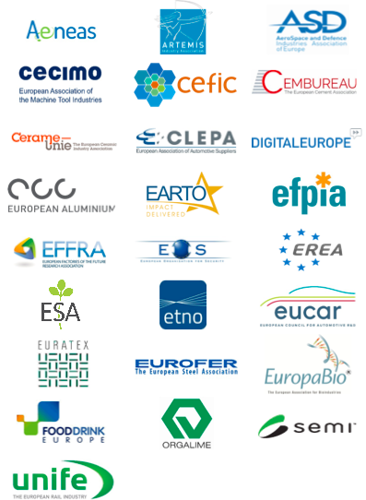Boosting Europe’s Future Competitiveness as Key Priority for FP9
We, the undersigned associations representing key European industrial research and innovation stakeholders, call on the European Commission, the European Parliament and the Council of the European Union to develop the next EU Research & Innovation Framework Programme (FP9) with an appropriate design and budget, at the level of the ambitions of the Renewed EU Industrial Policy Strategy.
The crucial role of Research, Development and Innovation (RD&I) activities to support and boost industrial leadership is now at the heart of the renewed European Industrial Policy Strategy[1] with the ultimate goals to benefit society. Europe’s future competitiveness and the sustainability of the European social model largely depend on RD&I: two-thirds of economic growth in Europe derives today from RD&I[2]. RD&I investments are the key drivers of the technological developments at the basis of many impactful innovations for society. However, RD&I intensity is much lower in Europe than in other countries like the US, China, Japan or South Korea. Reaching the EU’s objective of 3% GDP expenditure on R&D will require strong additional spending[3].
As already stated in a previous joint declaration[4], in order to fulfil European Commission President Jean-Claude Juncker’s wish to “make our industry stronger and more competitive” and “help our industries stay or become the world leader in innovation”[5], FP9 should from the start prioritise support to industrial competitiveness. This requires an ambitious strategy, taking full advantage of current research successes, understanding emerging risks and opportunities, considering the wider international industrial landscape, and focusing on European added value.
To boost our competitiveness by increasing our productivity, the EU needs to anticipate developments in the US and Asia in key technology areas that form the basis of our society’s future products and services. Accordingly, FP9 design should reflect such priorities and aim at:
- Maximising the impact of the EU funded RD&I for society, building on Horizon 2020’s efforts. This includes continued support to de-risk and incentivise private sector RD&I investments, as key components of EU renewed industrial policy strategy.
- Strengthening European Industries’ capacities to further absorb and scale up novel technologies[6] matured into new products and services - with the support of Horizon 2020 and national RD&I programmes - and apply them in addressing global challenges. FP9 design should maximise the participation of industries of all sizes to promote a competitive RD&I ecosystem capable of better absorbing recently developed innovations and technologies for the benefit of the whole society.
- Strengthening Europe’s capabilities to keep on top of the “innovation race” with third countries in order to safeguard Europe’s economic growth and employment. The forthcoming FP9 should enable Europe to remain at the forefront of RD&I by supporting the development of innovative technologies and skills with the view to address societal challenges and create new markets and new industries.
- Supporting European cross-border industry-driven collaborative RD&I, which is needed more than ever before to make the ongoing technological transitions a success for both European economy and society. In this context, European public-private partnerships (cPPPs and JTIs) shall continue to play a crucial role in leveraging private sector investments, linking those with EU, national and regional efforts, as well as in helping SMEs and Start-ups engage in EU and international supply chains, while working with key knowledge partners like Research and Technology Organisations.
We, the 25 signatories of this Joint Declaration, are ready to strengthen our cooperation with the European Commission, the European Parliament, and the Council of the European Union to define and implement an ambitious FP9. In line with the Treaty on the Functioning of the European Union, FP9 should have the objective of strengthening not only Europe’s scientific basis, but also its technological basis, encouraging the development of a competitive European RD&I ecosystem. This will be paramount to position Europe as a global industrial leader and to safeguard our growth and employment.

[1] EC Communication on Investing in a smart, innovative and sustainable Industry: A renewed EU Industrial Policy Strategy, 2017.
[2] EC Report, The Economic rationale for public R&I funding and its impact, 2017.
[3] Including by Member States.
[4] Joint Declaration by Industry and RTOs: An Ambitious FP9 Strengthening Europe's Industrial Leadership - 7 June 2017.
[5] EC President Jean-Claude Juncker Annual State of the Union Speech, 13 September 2017.
[6] Including Key Enabling Technologies (KETs).